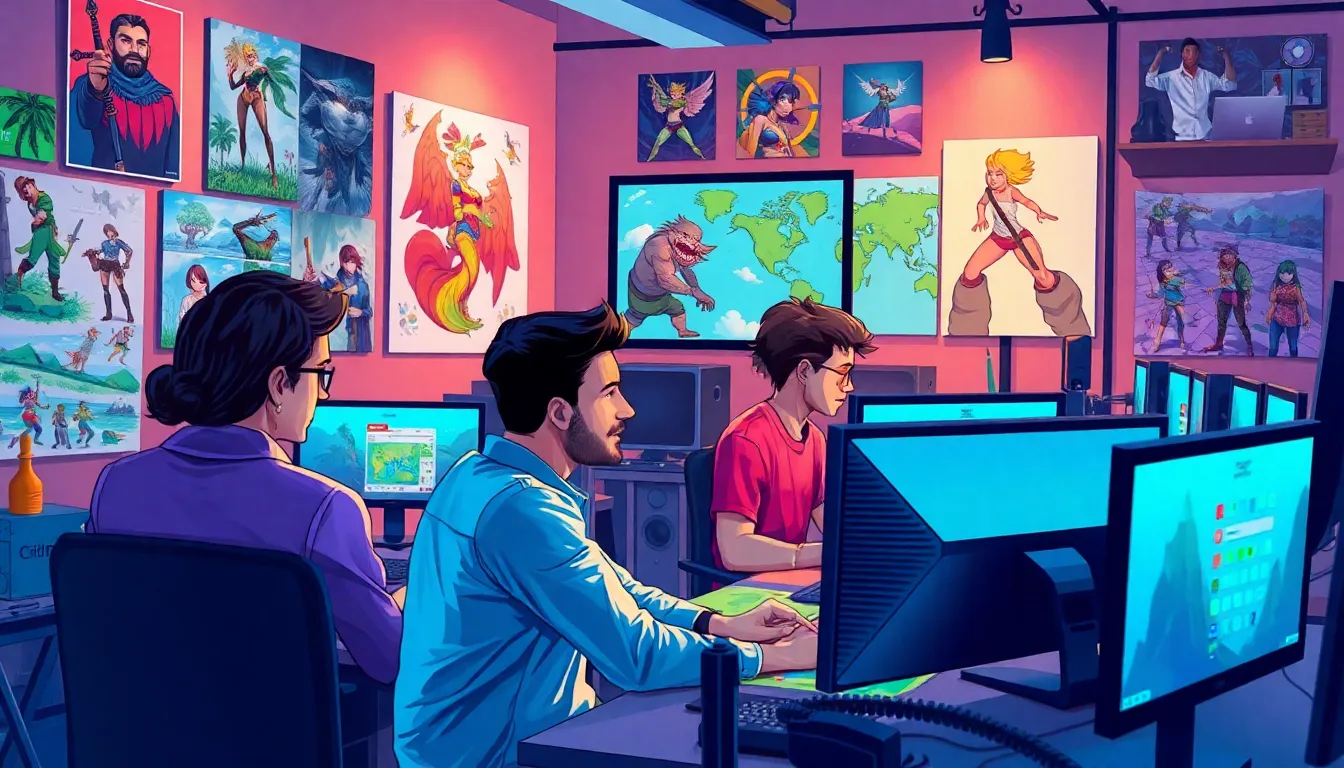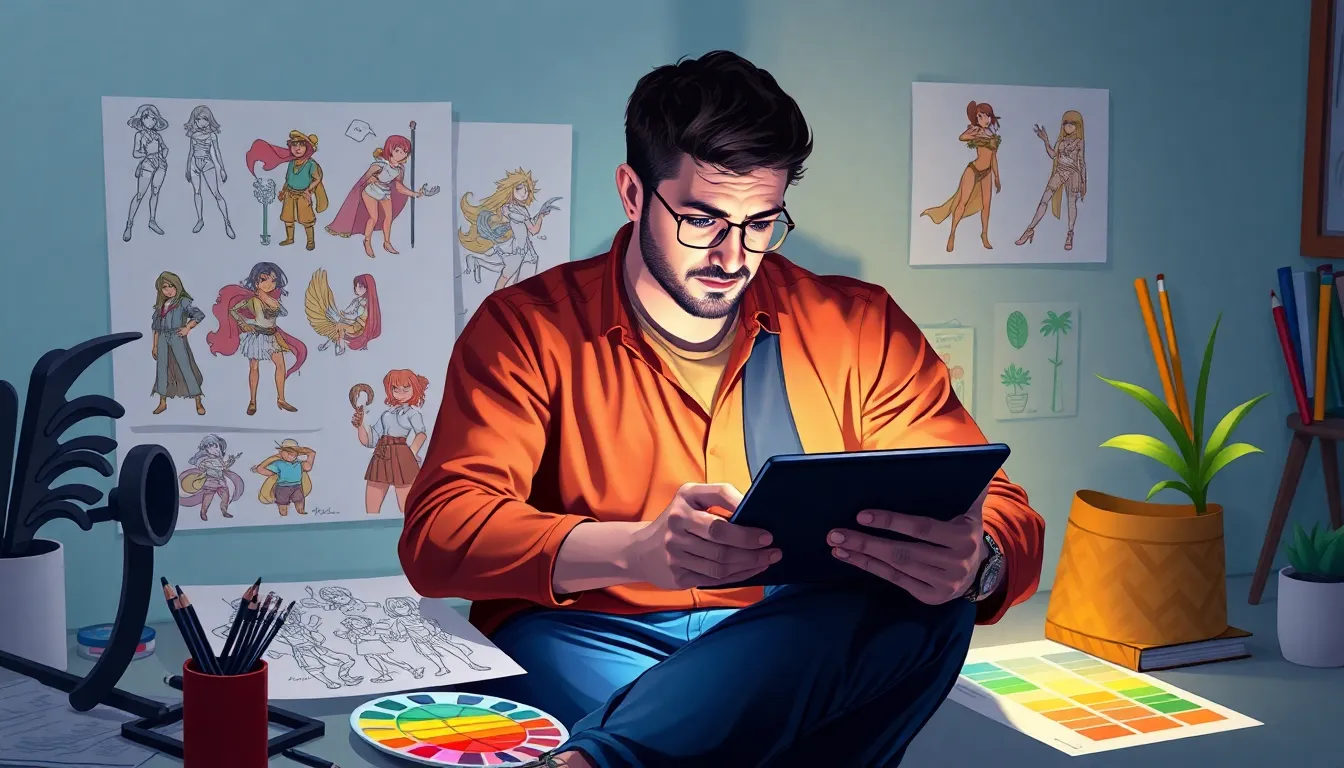In the vibrant world of gaming, art and design are the unsung heroes, crafting immersive experiences that keep players glued to their screens. From the whimsical landscapes of fantasy realms to the gritty textures of post-apocalyptic worlds, every pixel plays a part in telling a story. Without these creative wizards, games would be little more than a collection of boring numbers and code—yawn!
Game Art and Design
Game art and design play a critical role in developing engaging gaming experiences. Visual elements immerse players in different worlds while enhancing storytelling.Definition of Game Art
Game art refers to the visual components that bring a game to life, including character designs, environments, and animations. Artists create assets using techniques such as 2D and 3D modeling, texture painting, and concept art. Every art style, whether realistic or stylized, contributes to a game’s overall aesthetic. Game art not only reflects a specific genre but also evokes emotions aligned with gameplay. Vibrant colors, intricate details, and cohesive themes unite to shape player perception and engagement. Without game art, a game’s visual narrative remains incomplete.Importance of Game Design
Game design encompasses the mechanics, rules, and systems that define gameplay. It ensures that players enjoy a balanced and engaging experience. Designers prioritize player interaction by creating intuitive controls and rewarding game progression. Effective game design encourages exploration and strategic thinking. Thoughtful mechanics dictate how players interact with the environment and each other. Well-designed games promote accessibility, allowing a wider audience to enjoy the experience. Players often remember compelling game designs long after they finish playing.Key Elements of Game Art

Visual Style
Visual style represents the overall aesthetic that defines a game’s look. It emerges from choices like character design, environment art, and animation techniques. For instance, a cartoonish style may appeal to younger audiences, while a realistic approach often targets older players. Different styles enhance the game’s narrative, drawing players into its world. Each visual choice contributes to conveying emotions, setting moods, and reinforcing themes.Color Theory
Color theory affects player perception and mood throughout the gaming experience. Colors evoke emotions, guiding players’ responses to in-game events. Bright colors tend to inspire excitement and energy, while darker hues can create tension or sadness. Designers utilize color palettes strategically to unify the visual style and enhance storytelling. For example, contrasting colors can highlight important elements, drawing attention where needed. Understanding color psychology remains essential for effective game art and design.Game Design Principles
Game design principles play a pivotal role in creating engaging and enjoyable experiences for players. These principles encompass various aspects that make games more appealing and intuitive.Gameplay Mechanics
Gameplay mechanics define how players interact within the game environment. They include rules, objectives, and systems that shape the player’s journey. Effective mechanics ensure a balance between challenge and skill, keeping players invested. For instance, reward systems enhance motivation, while player feedback provides essential cues regarding progress. Diverse mechanics, such as puzzle-solving or combat, cater to varied player preferences, enriching the overall experience. The integration of mechanics with story elements amplifies immersion, forging deeper connections between players and game narratives.User Experience
User experience (UX) revolves around how players perceive and engage with the game. It encompasses interface design, control responsiveness, and overall accessibility. Clear visual hierarchies guide players through menus and gameplay, ensuring seamless navigation. Positive UX fosters player retention, as intuitive controls minimize frustration and enhance enjoyment. Incorporating user feedback during testing phases can lead to improvements in gameplay flow. Additionally, ensuring accessibility for all players opens doors to wider audiences, creating an inclusive gaming environment that values diverse perspectives.The Role of Collaboration in Game Development
Collaboration plays an essential role in game development, uniting various talents to create a cohesive gaming experience. Team members, including artists, designers, and programmers, work closely to foster creativity while aligning their visions.Artists and Designers Working Together
Artists and designers collaborate effectively to bring game concepts to life. Character artists create visually appealing characters while the designers ensure these characters fit seamlessly into the overall gameplay. Environment artists craft detailed worlds, focusing on aesthetics, while designers outline level structures and player interactions. Communication remains vital; frequent discussions between artists and designers help refine ideas and tackle challenges collaboratively. Ultimately, this synergy enhances visual storytelling, creating immersive experiences that resonate with players.Importance of Feedback
Feedback holds significant value in the game development process. Regular critiques between team members help identify strengths and weaknesses in art and design elements. Artists benefit from input on how their visuals support gameplay, while designers receive insights on how mechanics align with visual assets. Gathering feedback from playtests also provides crucial information on player enjoyment and engagement. Constructive criticism fosters improvement, allowing for iterative adjustments. Therefore, integrating feedback channels throughout the development cycle becomes essential for creating polished and engaging games.Trends in Game Art and Design
Current trends in game art and design showcase innovation and creativity. Artists and designers continually adapt to new technologies, enhancing visual storytelling.Emerging Technologies
Virtual reality (VR) and augmented reality (AR) transform game experiences. These technologies immerse players in interactive worlds, providing unprecedented engagement. 3D art tools, such as Blender and ZBrush, streamline character modeling and environment creation. With the advent of AI, designers automate repetitive tasks and generate assets, freeing time for creative exploration. Advanced rendering techniques increase realism, allowing designers to create stunning visuals that captivate audiences.
With the advent of AI, designers automate repetitive tasks and generate assets, freeing time for creative exploration. Advanced rendering techniques increase realism, allowing designers to create stunning visuals that captivate audiences.



